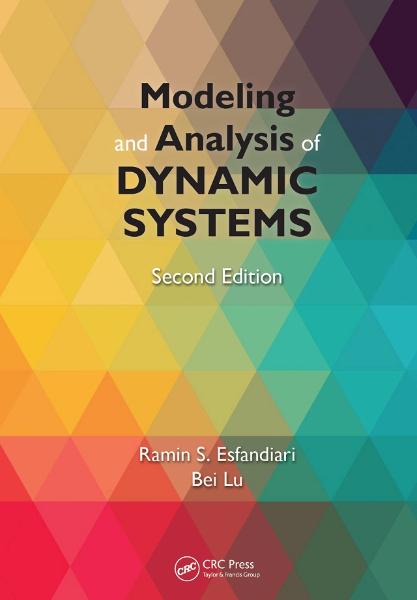|
نویسنده : www.BartarFile.ir
|

|
کتاب مدلسازی و تحلیل سیستم های دینامیکی (Modeling and Analysis of Dynamic Systems)، مشتمل بر 10 فصل، 558 صفحه، به زبان انگلیسی، همراه با تصاویر، فرمول ها و جداول مهم، با فرمت pdf، به ترتیب زیر گردآوری شده است:
Chapter 1: Introduction to MATLAB, Simulink, and Simscape
- MATLAB Command Window and Command Prompt
- User Defined Functions and Script Files
- Creating a Script File
- Defining and Evaluating Functions
- Iterative Calculations
- Matrices and Vectors
- Differentiation and Integration
- Plotting in MATLAB
- Plotting Data Points
- Plotting Analytical Expressions
- Simulink
- Block Library
- Building a New Model
- Simulation
- Simscape
- Block Library
- Building a New Model and Simulation
- Simulation
Chapter 2: Complex Analysis, Differential Equations, and Laplace Transformation
- Complex Analysis
- Complex Numbers in Rectangular Form
- Magnitude
- Complex Conjugate
- Complex Numbers in Polar Form
- Complex Algebra Using the Polar Form
- Integer Powers of Complex Numbers
- Roots of Complex Numbers
- Complex Variables and Functions
- Differential Equations
- Linear, First-Order Differential Equations
- Second-Order Differential Equations with Constant Coefficients
- Homogeneous Solution
- Particular Solution
- Laplace Transformation
- Linearity of Laplace and Inverse Laplace Transforms
- Differentiation and Integration of Laplace Transforms
- Differentiation of Laplace Transforms
- Integration of Laplace Transforms
- Special Functions
- Unit-Step Function
- Unit-Ramp Function
- Unit-Pulse Function
- Unit-Impulse (Dirac Delta) Function
- The Relation between Unit-Impulse and Unit-Step
- Functions
- Periodic Functions
- Laplace Transforms of Derivatives and Integrals
- Laplace Transforms of Derivatives
- Laplace Transforms of Integrals
- Inverse Laplace Transformation
- Partial-Fraction Expansion Method
- Performing Partial Fractions in MATLAB
- Convolution Method
- Final-Value Theorem and Initial-Value Theorem
- Final-Value Theorem
- Initial-Value Theorem
- Summary
Chapter 3: Matrix Analysis
- Vectors and Matrices
- Special Matrices
- Elementary Row Operations
- Rank of a Matrix
- Determinant of a Matrix
- Properties of Determinant
- Rank in Terms of Determinant
- Block Diagonal and Block Triangular Matrices
- Inverse of a Matrix
- Adjoint Matrix
- Solution of Linear Systems of Equations
- Gauss Elimination Method
- Using the Inverse of the Coefficient Matrix
- Cramer’s Rule
- Homogeneous Systems
- Matrix Eigenvalue Problem
- Solving the Eigenvalue Problem
- Algebraic Multiplicity and Geometric Multiplicity
- Generalized Eigenvectors
- Similarity Transformations
- Matrix Diagonalization
- Defective Matrices
- Summary
Chapter 4: System Model Representation
- Configuration Form
- Second-Order Matrix Form
- State-Space Form
- State Variables, State-Variable Equations, State Equation
- State-Variable Equations
- State Equation
- Output Equation, State-Space Form
- Output Equation
- State-Space Form
- Decoupling the State Equation
- Input–Output Equation, Transfer Function
- Input–Output Equations from the System Model
- Transfer Functions from the System Model
- Relations between State-Space Form, Input–Output Equation and Transfer Matrix
- Input–Output Equation to State-Space Form
- Controller Canonical Form
- State-Space Form to Transfer Matrix
- Block Diagram Representation
- Block Diagram Operations
- Summing Junction
- Series Combinations of Blocks
- Parallel Combinations of Blocks
- Integration
- Closed-Loop Systems
- Block Diagram Reduction Techniques
- Moving a Branch Point
- Moving a Summing Junction
- Mason’s Rule
- Block Diagram Construction from System Model
- Linearization
- Linearization of a Nonlinear Element
- Functions of Two Variables
- Linearization of a Nonlinear Model
- Operating Point
- Linearization Procedure
- Small-Angle Linearization
- Linearization with MATLAB Simulink
- Summary
Chapter 5: Mechanical Systems
- Mechanical Elements
- Mass Elements
- Spring Elements
- Damper Elements
- Equivalence
- Translational Systems
- Degrees of Freedom
- Newton’s Second Law
- Free-Body Diagrams
- Static Equilibrium Position and Coordinate Reference
- Massless Junctions
- D’Alembert’s Principle
- Rotational Systems
- General Moment Equation
- Modeling of Rigid Bodies in Plane Motion
- Mass Moment of Inertia
- Pure Rolling Motion
- Mixed Systems: Translational and Rotational
- Force and Moment Equations
- Energy Method
- Gear–Train Systems
- System Modeling with Simulink and Simscape
- Translational Systems
- Rotational Systems
- Summary
Chapter 6: Electrical, Electronic, and Electromechanical Systems
- Electrical Elements
- Resistors
- Inductors
- Capacitors
- Electric Circuits
- Kirchhoff’s Voltage Law
- Kirchhoff’s Current Law
- Node Method
- Loop Method
- State Variables of Circuits
- Operational Amplifiers
- Electromechanical Systems
- Elemental Relations of Electromechanical Systems
- Armature-Controlled Motors
- Field-Controlled Motors
- Impedance Methods
- Impedances of Electric Elements
- Series and Parallel Impedances
- Mechanical Impedances
- System Modeling with Simulink and Simscape
- Electric Circuits
- Operational Amplifiers
- DC Motors
- Summary
Chapter 7: Fluid and Thermal Systems
- Pneumatic Systems
- Ideal Gases
- Pneumatic Capacitance
- Modeling of Pneumatic Systems
- Liquid-Level Systems
- Hydraulic Capacitance
- Hydraulic Resistance
- Modeling of Liquid-Level Systems
- Thermal Systems
- First Law of Thermodynamics
- Thermal Capacitance
- Thermal Resistance
- Modeling of Heat Transfer Systems
- System Modeling with Simulink and Simscape
- Summary
Chapter 8: System Response
- Types of Response
- Transient Response and Steady-State Response
- Transient Response of First-Order Systems
- Free Response of First-Order Systems
- Impulse Response of First-Order Systems
- Step Response of First-Order Systems
- Ramp Response of First-Order Systems
- Transient Response of Second-Order Systems
- Free Response of Second-Order Systems
- Initial Response in MATLAB
- Impulse Response of Second-Order Systems
- Impulse Response in MATLAB
- Step Response of Second-Order Systems
- Step Response in MATLAB
- Response Analysis Using MATLAB Simulink
- Frequency Response
- Frequency Response of Stable, Linear Systems
- Frequency Response of First-Order Systems
- Frequency Response of Second-Order Systems
- Bode Diagram
- Plotting Bode Diagrams in MATLAB
- Bode Diagram of First-Order Systems
- Bode Diagram of Second-Order Systems
- Solving the State Equation
- Formal Solution of the State Equation
- Matrix Exponential
- Formal Solution in MATLAB
- Solution of the State Equation via Laplace Transformation
- Solution of the State Equation via State-Transition Matrix
- Response of Nonlinear Systems
- Numerical Solution of the State-Variable Equations
- Fourth-Order Runge–Kutta Method
- Response via MATLAB Simulink
- Response of the Linearized Model
- Summary
Chapter 9: Introduction to Vibrations
- Free Vibration
- Logarithmic Decrement
- Coulomb Damping
- Forced Vibration
- Half-Power Bandwidth
- Rotating Unbalance
- Harmonic Base Excitation
- Vibration Suppressions
- Vibration Isolators
- Vibration Absorbers
- Modal Analysis
- Eigenvalue Problem
- Orthogonality of Modes
- Response to Initial Excitations
- Response to Harmonic Excitations
- Vibration Measurement and Analysis
- Vibration Measurement
- System Identification
- Summary
Chapter 10: Introduction to Feedback Control Systems
- Basic Concepts and Terminologies
- Stability and Performance
- Stability of Linear Time-Invariant Systems
- Time-Domain Performance Specifications
- Frequency-Domain Performance Specifications
- Benefits of Feedback Control
- Stabilization
- Disturbance Rejection
- Reference Tracking
- Sensitivity to Parameter Variations
- Proportional–Integral–Derivative Control
- Proportional Control
- Proportional–Integral Control
- PID Control
- Ziegler–Nichols Tuning of PID Controllers
- Root Locus
- Root Locus of a Basic Feedback System
- Analysis Using Root Locus
- Control Design Using Root Locus
- Bode Plot
- Bode Plot of a Basic Feedback System
- Analysis Using Bode Plot
- Control Design Using Bode Plot
- Full-State Feedback
- Analysis of State-Space Equations
- Control Design for Full-State Feedback
- Integration of Simulink and Simscape into Control Design
- Control System Simulation Using Simulink
- Integration of Simscape into Control System Simulation
مبانی دینامیک خودرو
ارتعاشات مکانیکی، تئوری و کاربردها
تعمیرات بر اساس شرایط کار ماشین (آنالیز ارتعاشات، آنالیز صوت و آنالیز روغن)

جهت دانلود کتاب مدلسازی و تحلیل سیستم های دینامیکی (Modeling and Analysis of Dynamic Systems)، بر لینک زیر کلیک نمایید:
کتاب مدلسازی و تحلیل سیستم های دینامیکی
اگر به فراگیری مباحث مشابه مطلب بالا علاقهمند هستید، آموزشهایی که در ادامه آمدهاند نیز به شما پیشنهاد میشوند:
شبیه سازی ارتعاشات با استفاده از نرم افزارهای متلب و انسیس
مجموعه جزوات کارشناسی ارشد مهندسی مکانیک
پرسش و پاسخ ارتعاشات مکانیکی تامسون
مدلسازی سیستم کروز کنترل در نرم افزار متلب
طراحی و انتخاب کلاچ ها و ترمزها
شبیه سازی و آنالیز سیستم تعلیق و فرمان خودرو با نرم افزار آدامز



 آمار
وبلاگ:
آمار
وبلاگ: